
aigverse
A Python library for working with logic networks, synthesis, and optimization.
Stars: 65
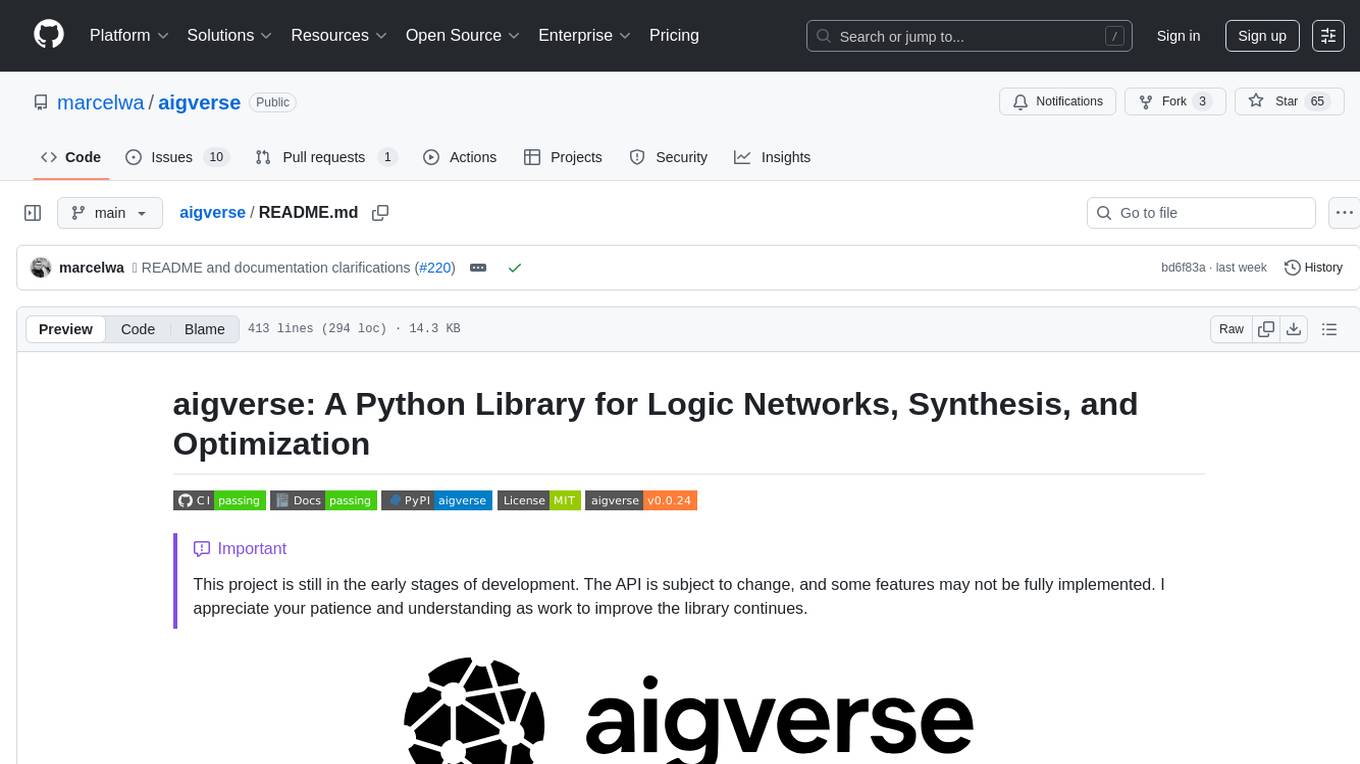
aigverse is a Python infrastructure framework that bridges the gap between logic synthesis and AI/ML applications. It allows efficient representation and manipulation of logic circuits, making it easier to integrate logic synthesis and optimization tasks into machine learning pipelines. Built upon EPFL Logic Synthesis Libraries, particularly mockturtle, aigverse provides a high-level Python interface to state-of-the-art algorithms for And-Inverter Graph (AIG) manipulation and logic synthesis, widely used in formal verification, hardware design, and optimization tasks.
README:
[!Important] This project is still in the early stages of development. The API is subject to change, and some features may not be fully implemented. I appreciate your patience and understanding as work to improve the library continues.
aigverse is a Python infrastructure framework designed to bridge the gap between logic synthesis and AI/ML
applications. It allows you to represent and manipulate logic circuits efficiently, making it easier to integrate logic
synthesis and optimization tasks into machine learning pipelines. aigverse is built directly upon the
powerful EPFL Logic Synthesis Libraries, particularly
mockturtle, providing a high-level Python interface to state-of-the-art
algorithms for And-Inverter Graph (AIG) manipulation and logic synthesis, widely used in formal verification, hardware
design, and optimization tasks.
- Efficient Logic Representation: Use And-Inverter Graphs (AIGs) to model and manipulate logic circuits in Python.
- File Format Support: Read and write AIGER, Verilog, Bench, PLA, ... files for interoperability with other logic synthesis tools.
- C++ Backend: Leverage the performance of the EPFL Logic Synthesis Libraries for fast logic synthesis and optimization.
- High-Level API: Simplify logic synthesis tasks with a Pythonic interface for AIG manipulation and optimization.
- Integration with Machine Learning: Convenient integration with popular data science libraries.
As AI and machine learning (ML) increasingly impact hardware design automation, there's a growing need for tools that
integrate logic synthesis with ML workflows. aigverse provides a Python-friendly interface for logic synthesis, making
it easier to develop applications that blend both AI/ML and traditional circuit synthesis techniques. By building upon
the robust foundation of the EPFL Logic Synthesis Libraries, aigverse delivers powerful logic manipulation
capabilities while maintaining accessibility through its Python interface. With aigverse, you can parse, manipulate,
and optimize logic circuits directly from Python. We aim to provide seamless integration with popular ML
libraries, enabling the development of novel AI-driven synthesis and optimization tools.
aigverse is built using the EPFL Logic Synthesis Libraries with pybind11.
It is available via PyPI for all major operating systems and supports Python 3.9 to 3.13.
pip install aigverseTo keep the core library lightweight, machine learning integration adapters are not installed by default. These adapters
enable seamless conversion of AIGs to graph and array formats for use with ML and data science libraries (such as
NetworkX, NumPy, etc.). To install aigverse with the adapters extra,
use:
pip install "aigverse[adapters]"This will install additional dependencies required for ML workflows. See the documentation for more details.
The following gives a shallow overview on aigverse. Detailed documentation and examples are available at
ReadTheDocs.
In aigverse, you can create a simple And-Inverter Graph (AIG) and manipulate it using various logic operations.
from aigverse import Aig
# Create a new AIG network
aig = Aig()
# Create primary inputs
x1 = aig.create_pi()
x2 = aig.create_pi()
# Create logic gates
f_and = aig.create_and(x1, x2) # AND gate
f_or = aig.create_or(x1, x2) # OR gate
# Create primary outputs
aig.create_po(f_and)
aig.create_po(f_or)
# Print the size of the AIG network
print(f"AIG Size: {aig.size()}")Note that all primary inputs (PIs) must be created before any logic gates.
You can iterate over all nodes in the AIG, or specific subsets like the primary inputs or only logic nodes (gates).
# Iterate over all nodes in the AIG
for node in aig.nodes():
print(f"Node: {node}")
# Iterate only over primary inputs
for pi in aig.pis():
print(f"Primary Input: {pi}")
# Iterate only over logic nodes (gates)
for gate in aig.gates():
print(f"Gate: {gate}")
# Iterate over the fanins of a node
n_and = aig.get_node(f_and)
for fanin in aig.fanins(n_and):
print(f"Fanin of {n_and}: {fanin}")You can compute the depth of the AIG network and the level of each node. Depth information is useful for estimating the critical path delay of a respective circuit.
from aigverse import DepthAig
depth_aig = DepthAig(aig)
print(f"Depth: {depth_aig.num_levels()}")
for node in aig.nodes():
print(f"Level of {node}: {depth_aig.level(node)}")If needed, you can retrieve the fanouts of AIG nodes as well:
from aigverse import FanoutAig
fanout_aig = FanoutAig(aig)
n_and = aig.get_node(f_and)
# Iterate over the fanouts of a node
for fanout in fanout_aig.fanouts(n_and):
print(f"Fanout of node {n_and}: {fanout}")aigverse also supports sequential AIGs, which are AIGs with registers.
from aigverse import SequentialAig
seq_aig = SequentialAig()
x1 = seq_aig.create_pi() # Regular PI
x2 = seq_aig.create_ro() # Register output (sequential PI)
f_and = seq_aig.create_and(x1, x2) # AND gate
seq_aig.create_ri(f_and) # Register input (sequential PO)
print(seq_aig.registers()) # Prints the association of registersIt is to be noted that the construction of sequential AIGs comes with some caveats:
- All register outputs (ROs) must be created after all primary inputs (PIs).
- All register inputs (RIs) must be created after all primary outputs (POs).
- As for regular AIGs, all PIs and ROs must be created before any logic gates.
You can optimize AIGs using various algorithms. For example, you can perform resubstitution to simplify logic using shared divisors. Similarly, refactoring collapses maximal fanout-free cones (MFFCs) into truth tables and resynthesizes them into new structures. Cut rewriting optimizes the AIG by replacing cuts with improved ones from a pre-computed NPN database. Finally, balancing performs (E)SOP factoring to minimize the number of levels in the AIG.
from aigverse import aig_resubstitution, sop_refactoring, aig_cut_rewriting, balancing
# Clone the AIG network for size comparison
aig_clone = aig.clone()
# Optimize the AIG with several optimization algorithms
for optimization in [aig_resubstitution, sop_refactoring, aig_cut_rewriting, balancing]:
optimization(aig)
# Print the size of the unoptimized and optimized AIGs
print(f"Original AIG Size: {aig_clone.size()}")
print(f"Optimized AIG Size: {aig.size()}")Equivalence of AIGs (e.g., after optimization) can be checked using SAT-based equivalence checking.
from aigverse import equivalence_checking
# Perform equivalence checking
equiv = equivalence_checking(aig1, aig2)
if equiv:
print("AIGs are equivalent!")
else:
print("AIGs are NOT equivalent!")You can read and write AIGs in various file formats, including (ASCII) AIGER, gate-level Verilog and PLA.
from aigverse import write_aiger, write_verilog, write_dot
# Write an AIG network to an AIGER file
write_aiger(aig, "example.aig")
# Write an AIG network to a Verilog file
write_verilog(aig, "example.v")
# Write an AIG network to a DOT file
write_dot(aig, "example.dot")from aigverse import (
read_aiger_into_aig,
read_ascii_aiger_into_aig,
read_verilog_into_aig,
read_pla_into_aig,
)
# Read AIGER files into AIG networks
aig1 = read_aiger_into_aig("example.aig")
aig2 = read_ascii_aiger_into_aig("example.aag")
# Read a Verilog file into an AIG network
aig3 = read_verilog_into_aig("example.v")
# Read a PLA file into an AIG network
aig4 = read_pla_into_aig("example.pla")Additionally, you can read AIGER files into sequential AIGs using read_aiger_into_sequential_aig and
read_ascii_aiger_into_sequential_aig.
AIGs support Python's pickle protocol, allowing you to serialize and deserialize AIG objects for persistent storage or
interface with data science or machine learning workflows.
import pickle
with open("aig.pkl", "wb") as f:
pickle.dump(aig, f)
with open("aig.pkl", "rb") as f:
unpickled_aig = pickle.load(f)You can also pickle multiple AIGs at once by storing them in a tuple or list.
With the adapters extra, you can convert an AIG to a NetworkX directed graph, enabling
visualization and use with graph-based ML tools:
import aigverse.adapters
G = aig.to_networkx(levels=True, fanouts=True, node_tts=True)Graph, node, and edge attributes provide logic, level, fanout, and function information for downstream ML or visualization tasks.
For more details and examples, see the machine learning integration documentation.
Small Boolean functions can be efficiently represented using truth tables. aigverse enables the creation and
manipulation of truth tables by wrapping a portion of the kitty library.
from aigverse import TruthTable
# Initialize a truth table with 3 variables
tt = TruthTable(3)
# Create a truth table from a hex string representing the MAJ function
tt.create_from_hex_string("e8")# Flip each bit in the truth table
for i in range(tt.num_bits()):
print(f"Flipping bit {int(tt.get_bit(i))}")
tt.flip_bit(i)
# Print a binary string representation of the truth table
print(tt.to_binary())
# Clear the truth table
tt.clear()
# Check if the truth table is constant 0
print(tt.is_const0())from aigverse import simulate, simulate_nodes
# Obtain the truth table of each AIG output
tts = simulate(aig)
# Print the truth tables
for i, tt in enumerate(tts):
print(f"PO{i}: {tt.to_binary()}")
# Obtain the truth tables of each node in the AIG
n_to_tt = simulate_nodes(aig)
# Print the truth tables of each node
for node, tt in n_to_tt.items():
print(f"Node {node}: {tt.to_binary()}")For machine learning applications, it is often useful to convert truth tables into standard data structures like Python
lists or NumPy arrays. Since TruthTable objects are iterable, conversion is straightforward.
import numpy as np
# Export to a list
tt_list = list(tt)
# Export to NumPy arrays
tt_np_bool = np.array(tt)
tt_np_int = np.array(tt, dtype=np.int32)
tt_np_float = np.array(tt, dtype=np.float64)Truth tables also support Python's pickle protocol, allowing you to serialize and deserialize them.
import pickle
with open("tt.pkl", "wb") as f:
pickle.dump(tt, f)
with open("tt.pkl", "rb") as f:
unpickled_tt = pickle.load(f)For a deeper dive into the vision and technical details behind aigverse, check out the presentation from the
Free Silicon Conference (FSiC) 2025:
"aigverse: Toward machine learning-driven logic synthesis" 📄 Slides available on the FSiC wiki
This talk covers the motivation, architecture, and future directions of aigverse as an infrastructure project for
bringing machine learning to logic synthesis.
Contributions are welcome! If you'd like to contribute to aigverse, please see the
contribution guide. I appreciate feedback and suggestions
for improving the library.
aigverse is and will always be a free, open-source library. If you or your organization require dedicated support,
specific new features, or integration of aigverse into your projects, professional consulting services are available.
This is a great way to get the features you need while also supporting the ongoing maintenance and development of the
library.
For inquiries, please reach out to @marcelwa. More information can be found in the documentation.
aigverse is available under the MIT License.
For Tasks:
Click tags to check more tools for each tasksFor Jobs:
Alternative AI tools for aigverse
Similar Open Source Tools

aigverse
aigverse is a Python infrastructure framework that bridges the gap between logic synthesis and AI/ML applications. It allows efficient representation and manipulation of logic circuits, making it easier to integrate logic synthesis and optimization tasks into machine learning pipelines. Built upon EPFL Logic Synthesis Libraries, particularly mockturtle, aigverse provides a high-level Python interface to state-of-the-art algorithms for And-Inverter Graph (AIG) manipulation and logic synthesis, widely used in formal verification, hardware design, and optimization tasks.
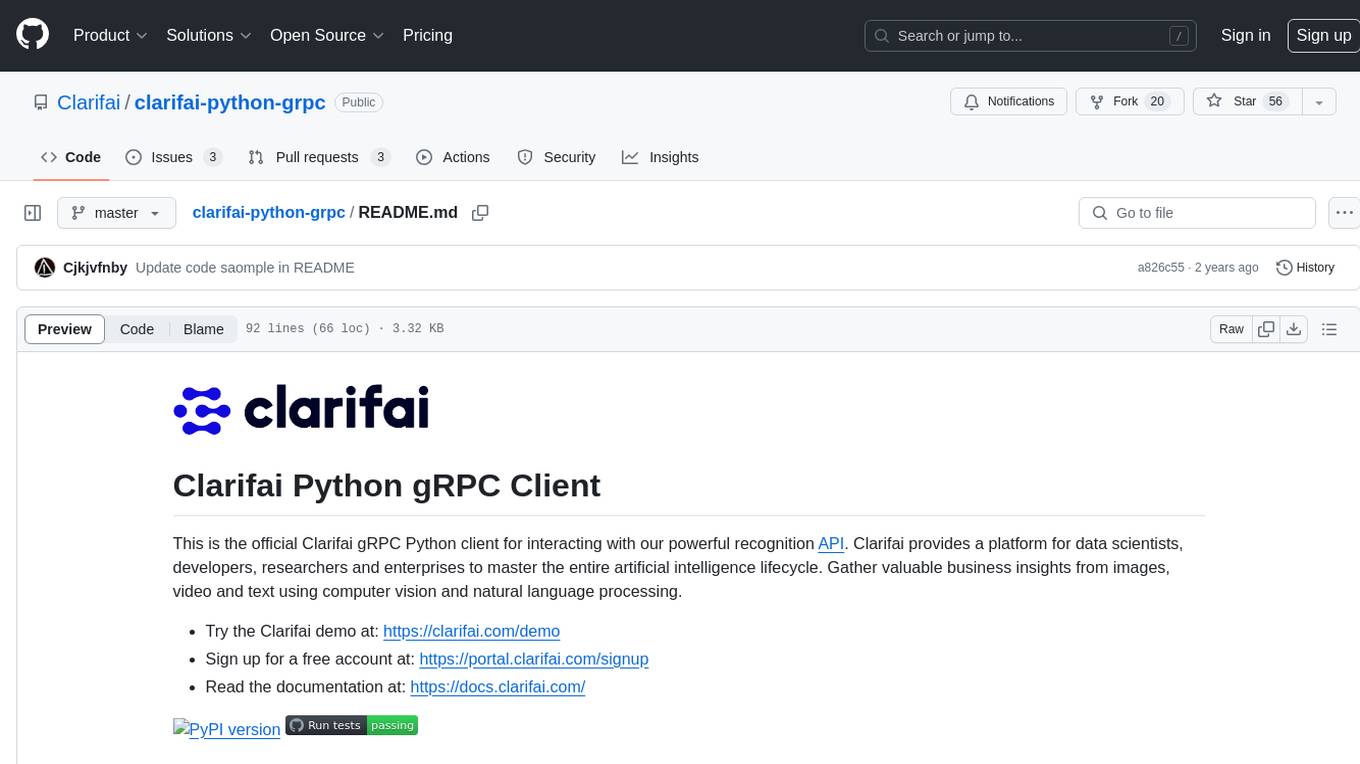
clarifai-python-grpc
This is the official Clarifai gRPC Python client for interacting with their recognition API. Clarifai offers a platform for data scientists, developers, researchers, and enterprises to utilize artificial intelligence for image, video, and text analysis through computer vision and natural language processing. The client allows users to authenticate, predict concepts in images, and access various functionalities provided by the Clarifai API. It follows a versioning scheme that aligns with the backend API updates and includes specific instructions for installation and troubleshooting. Users can explore the Clarifai demo, sign up for an account, and refer to the documentation for detailed information.
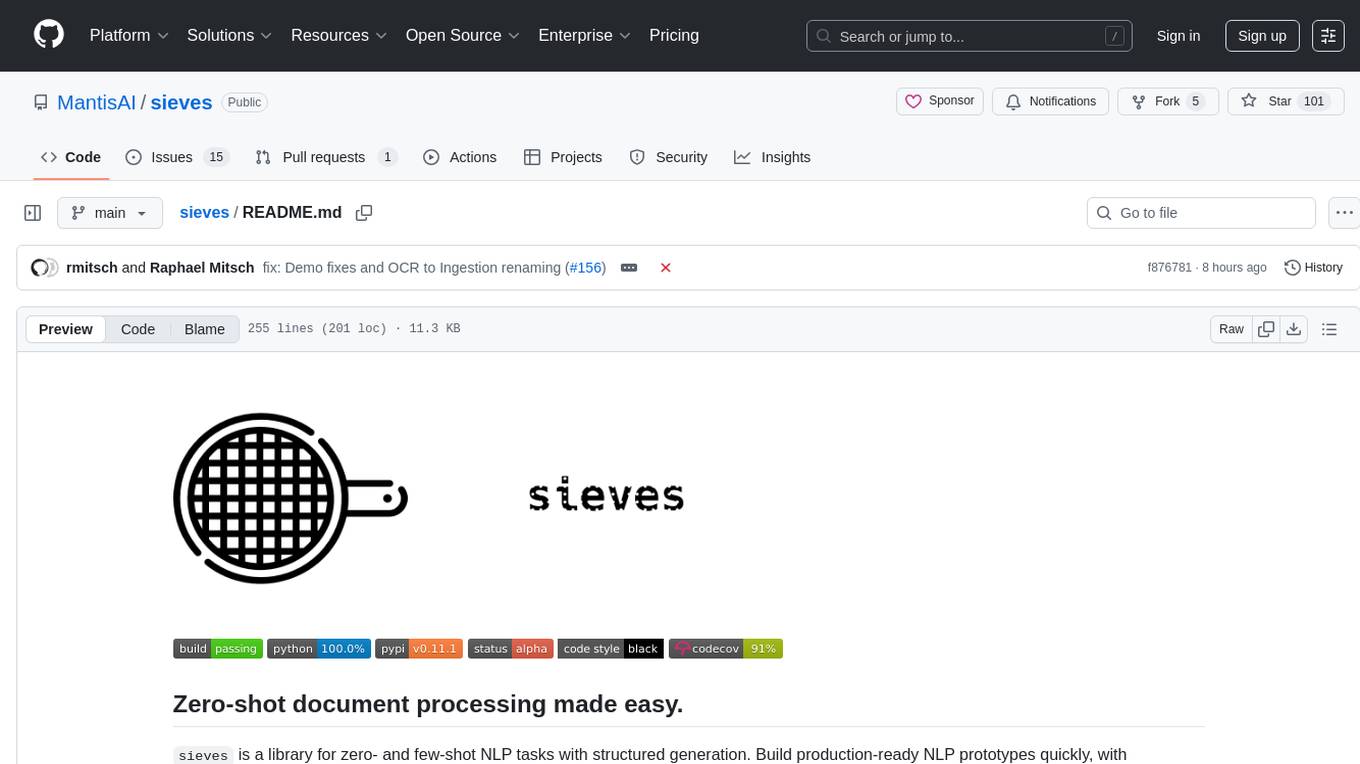
sieves
sieves is a library for zero- and few-shot NLP tasks with structured generation, enabling rapid prototyping of NLP applications without the need for training. It simplifies NLP prototyping by bundling capabilities into a single library, providing zero- and few-shot model support, a unified interface for structured generation, built-in tasks for common NLP operations, easy extendability, document-based pipeline architecture, caching to prevent redundant model calls, and more. The tool draws inspiration from spaCy and spacy-llm, offering features like immediate inference, observable pipelines, integrated tools for document parsing and text chunking, ready-to-use tasks such as classification, summarization, translation, and more, persistence for saving and loading pipelines, distillation for specialized model creation, and caching to optimize performance.
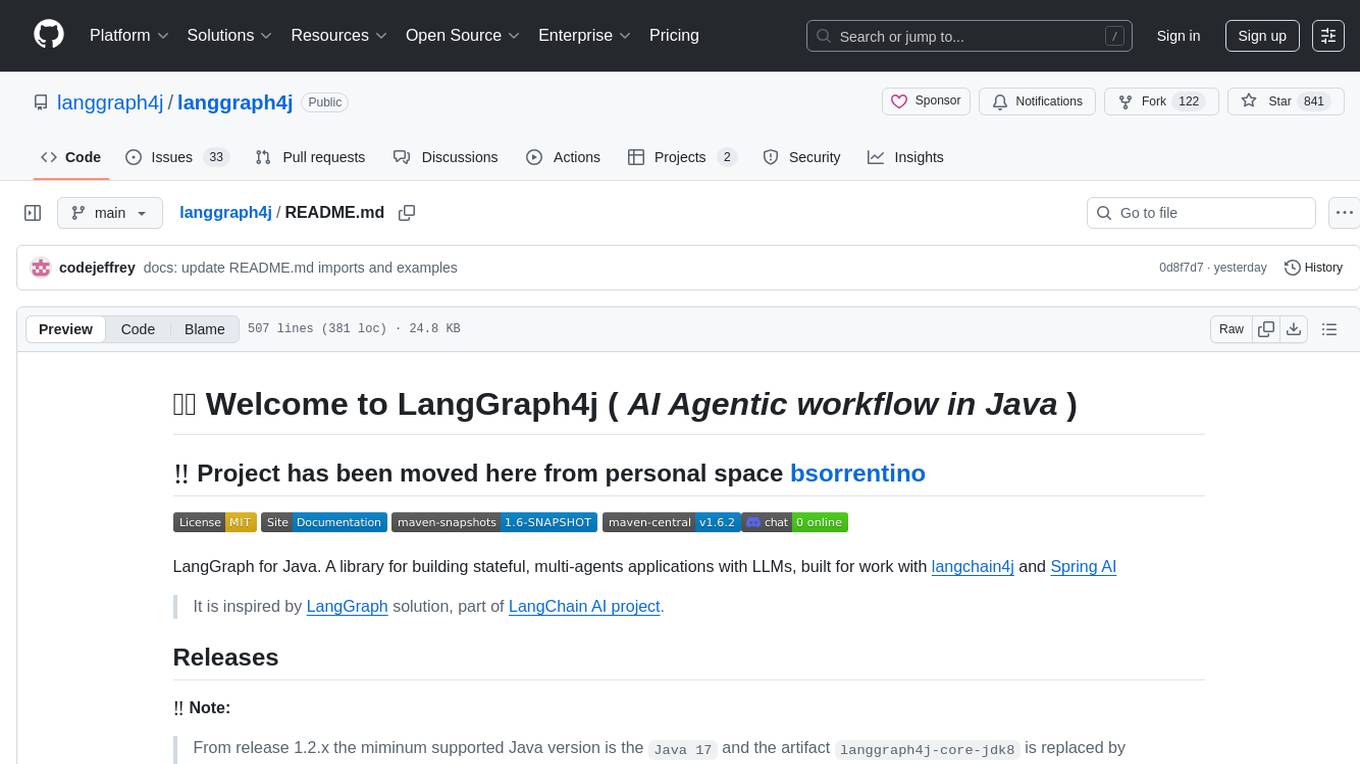
langgraph4j
Langgraph4j is a Java library for language processing tasks such as text classification, sentiment analysis, and named entity recognition. It provides a set of tools and algorithms for analyzing text data and extracting useful information. The library is designed to be efficient and easy to use, making it suitable for both research and production applications.
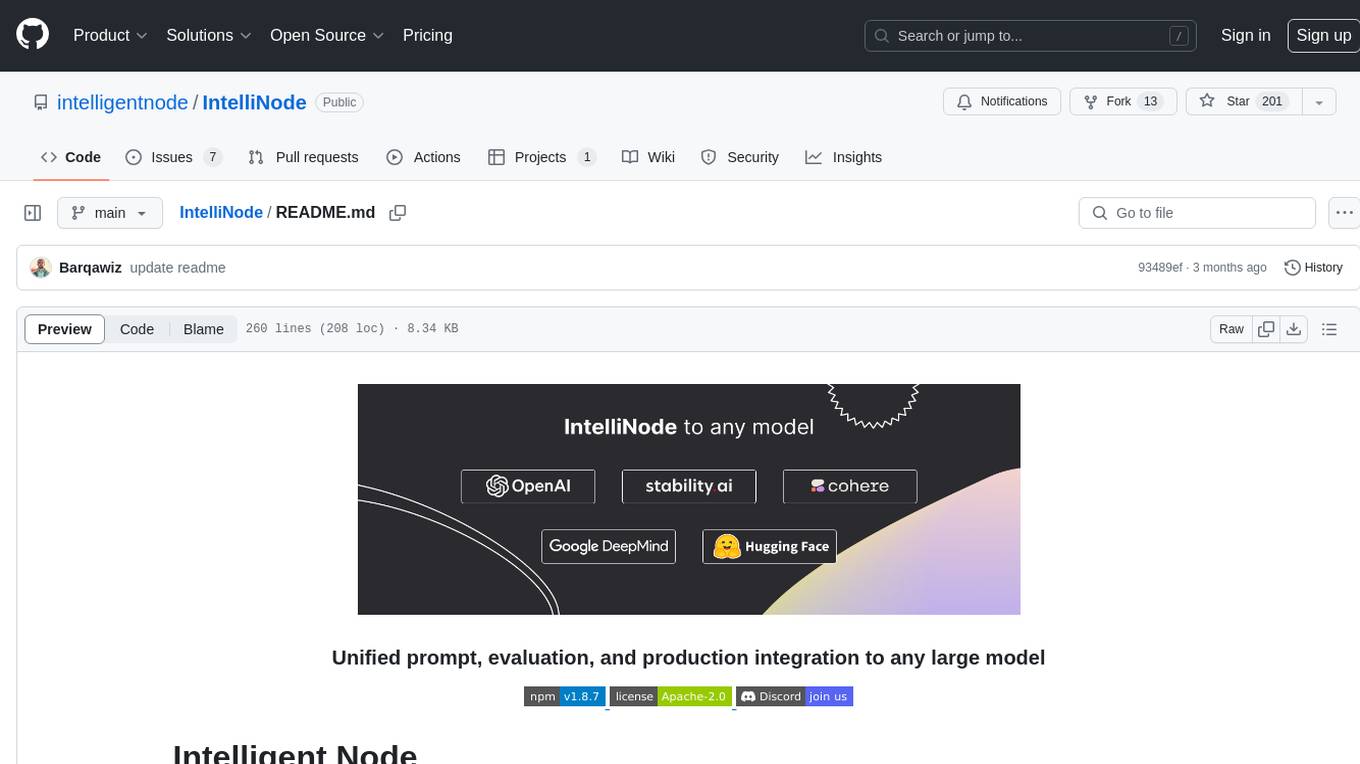
IntelliNode
IntelliNode is a javascript module that integrates cutting-edge AI models like ChatGPT, LLaMA, WaveNet, Gemini, and Stable diffusion into projects. It offers functions for generating text, speech, and images, as well as semantic search, multi-model evaluation, and chatbot capabilities. The module provides a wrapper layer for low-level model access, a controller layer for unified input handling, and a function layer for abstract functionality tailored to various use cases.
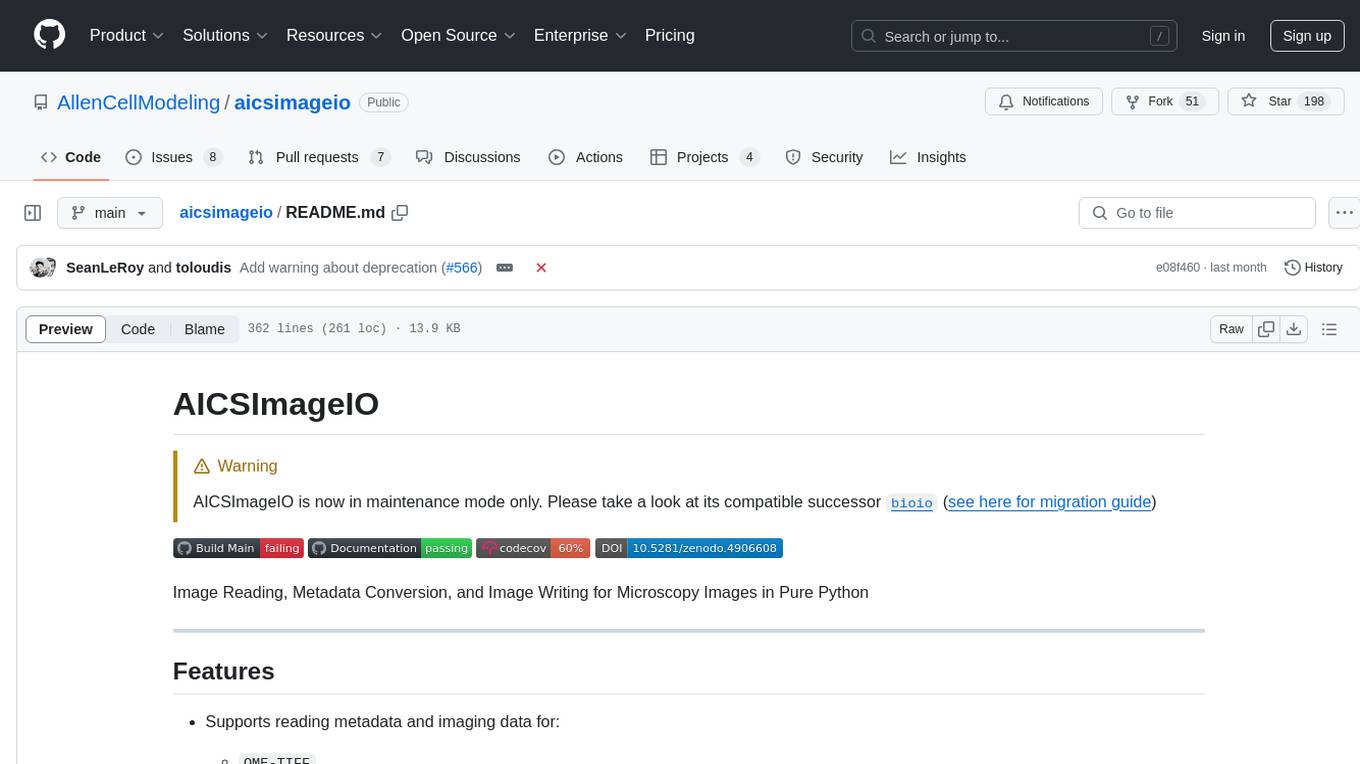
aicsimageio
AICSImageIO is a Python tool for Image Reading, Metadata Conversion, and Image Writing for Microscopy Images. It supports various file formats like OME-TIFF, TIFF, ND2, DV, CZI, LIF, PNG, GIF, and Bio-Formats. Users can read and write metadata and imaging data, work with different file systems like local paths, HTTP URLs, s3fs, and gcsfs. The tool provides functionalities for full image reading, delayed image reading, mosaic image reading, metadata reading, xarray coordinate plane attachment, cloud IO support, and saving to OME-TIFF. It also offers benchmarking and developer resources.
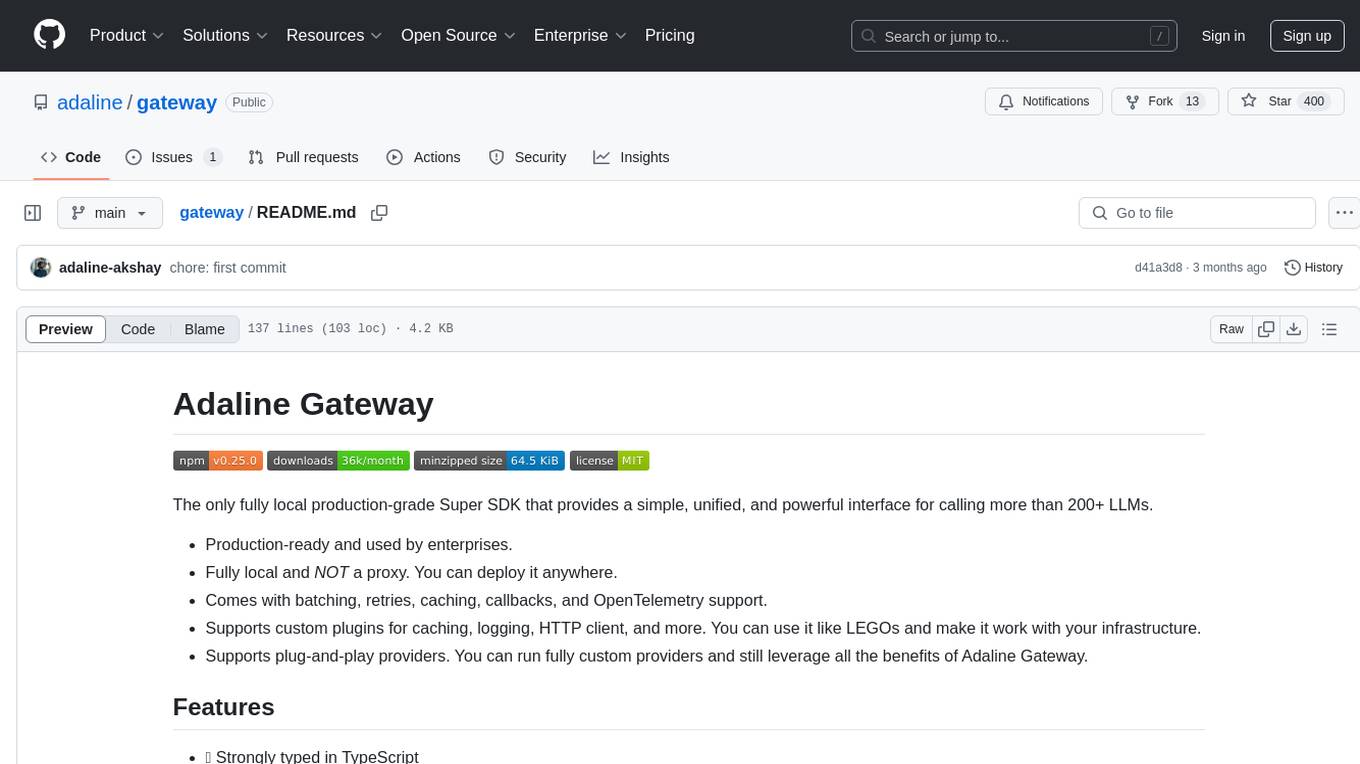
gateway
Adaline Gateway is a fully local production-grade Super SDK that offers a unified interface for calling over 200+ LLMs. It is production-ready, supports batching, retries, caching, callbacks, and OpenTelemetry. Users can create custom plugins and providers for seamless integration with their infrastructure.
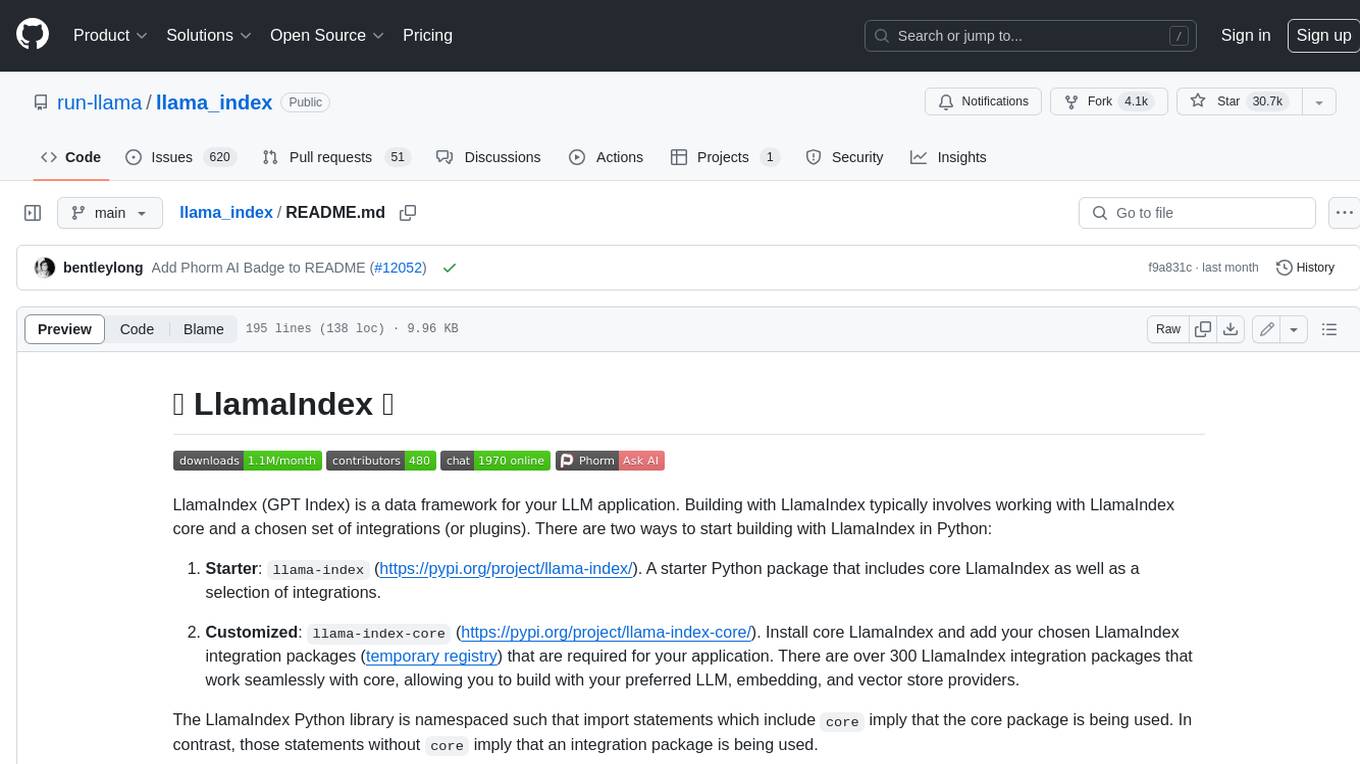
llama_index
LlamaIndex is a data framework for building LLM applications. It provides tools for ingesting, structuring, and querying data, as well as integrating with LLMs and other tools. LlamaIndex is designed to be easy to use for both beginner and advanced users, and it provides a comprehensive set of features for building LLM applications.
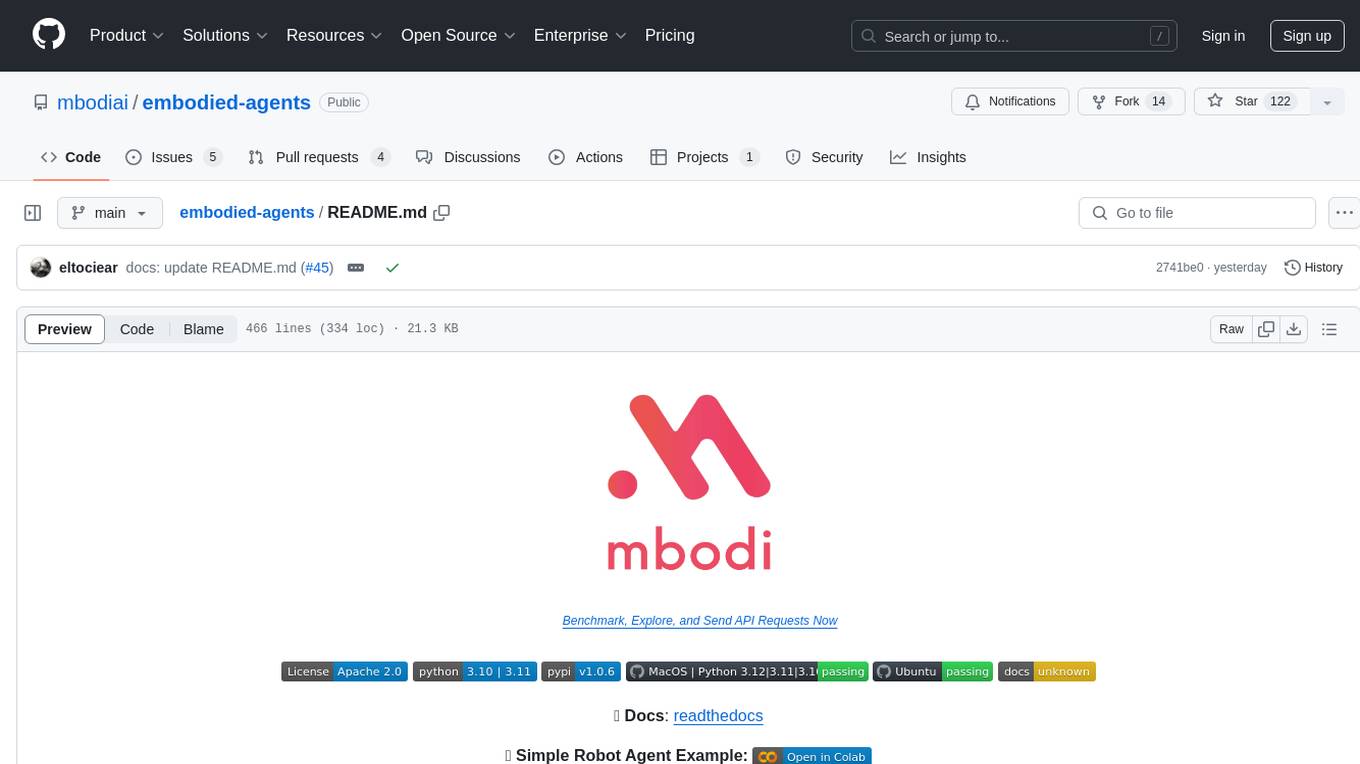
embodied-agents
Embodied Agents is a toolkit for integrating large multi-modal models into existing robot stacks with just a few lines of code. It provides consistency, reliability, scalability, and is configurable to any observation and action space. The toolkit is designed to reduce complexities involved in setting up inference endpoints, converting between different model formats, and collecting/storing datasets. It aims to facilitate data collection and sharing among roboticists by providing Python-first abstractions that are modular, extensible, and applicable to a wide range of tasks. The toolkit supports asynchronous and remote thread-safe agent execution for maximal responsiveness and scalability, and is compatible with various APIs like HuggingFace Spaces, Datasets, Gymnasium Spaces, Ollama, and OpenAI. It also offers automatic dataset recording and optional uploads to the HuggingFace hub.
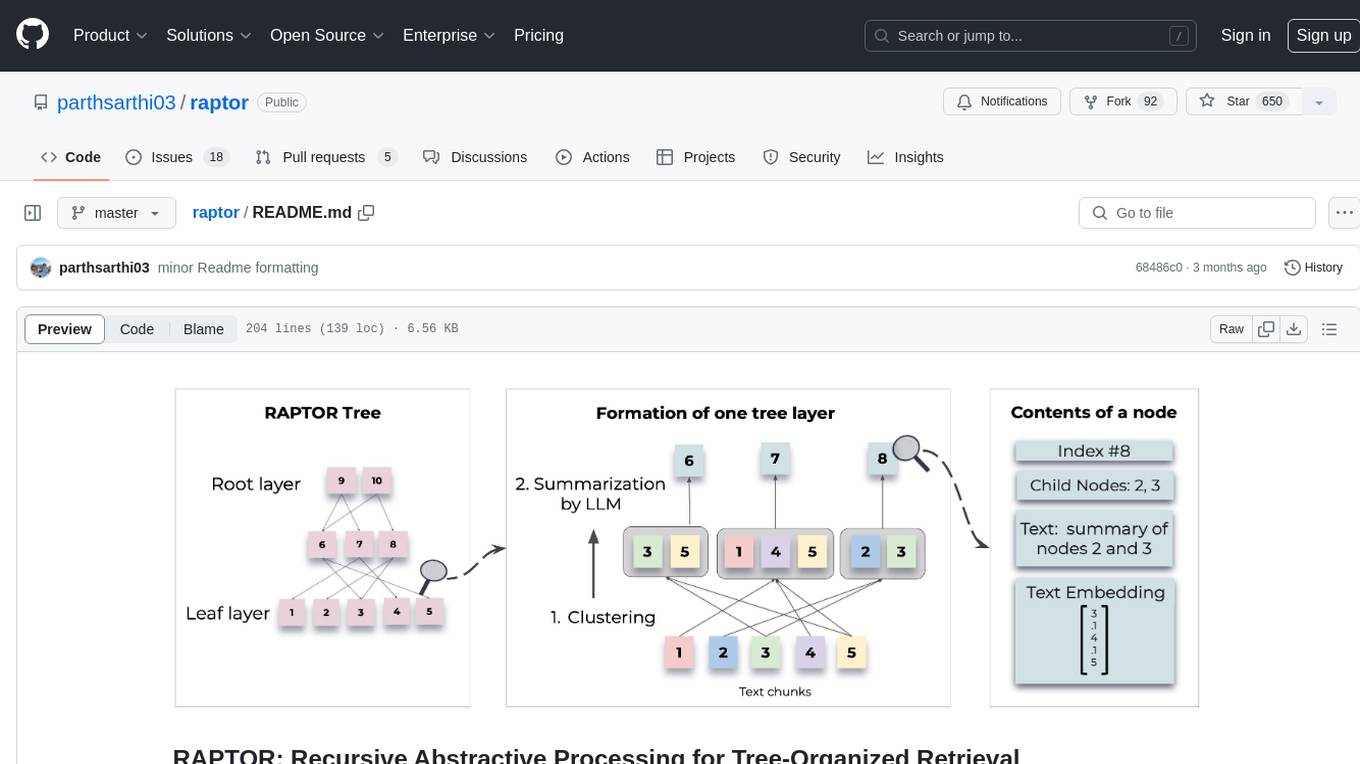
raptor
RAPTOR introduces a novel approach to retrieval-augmented language models by constructing a recursive tree structure from documents. This allows for more efficient and context-aware information retrieval across large texts, addressing common limitations in traditional language models. Users can add documents to the tree, answer questions based on indexed documents, save and load the tree, and extend RAPTOR with custom summarization, question-answering, and embedding models. The tool is designed to be flexible and customizable for various NLP tasks.
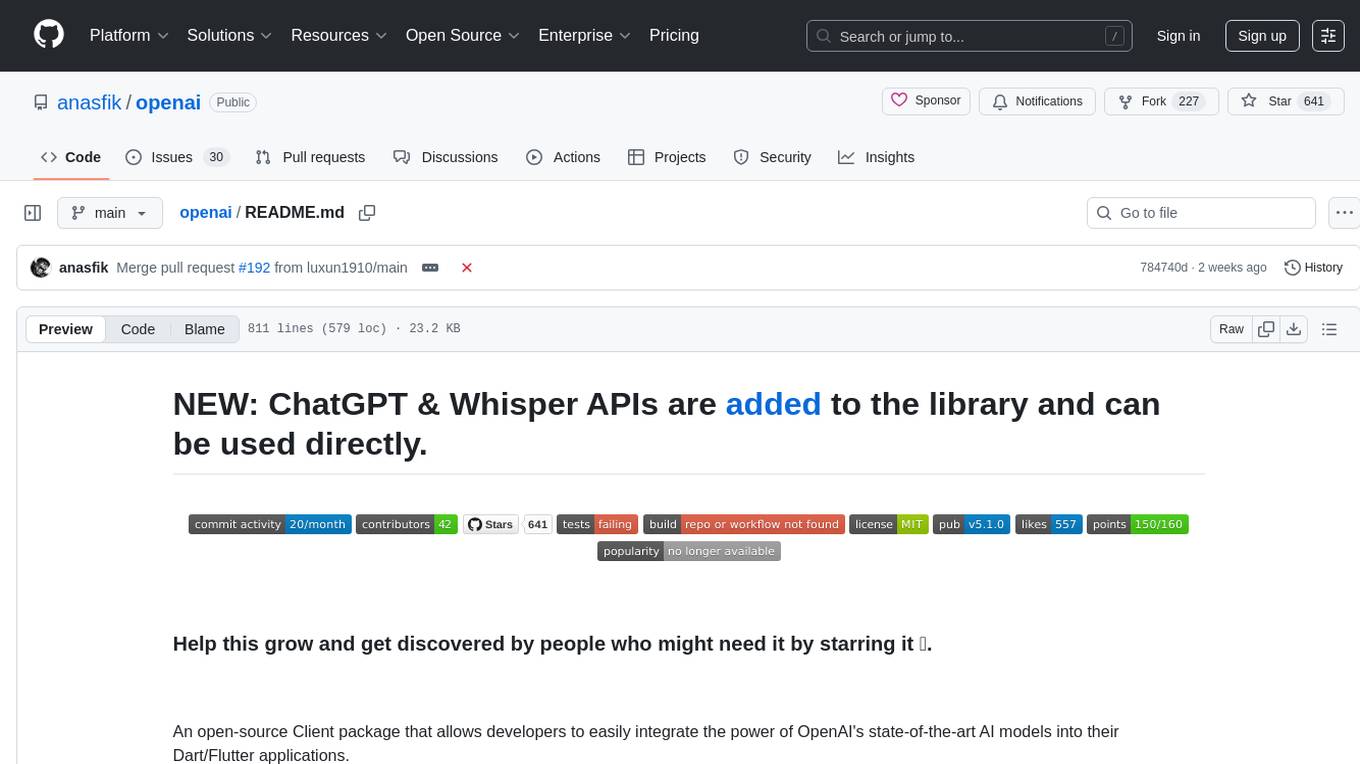
openai
An open-source client package that allows developers to easily integrate the power of OpenAI's state-of-the-art AI models into their Dart/Flutter applications. The library provides simple and intuitive methods for making requests to OpenAI's various APIs, including the GPT-3 language model, DALL-E image generation, and more. It is designed to be lightweight and easy to use, enabling developers to focus on building their applications without worrying about the complexities of dealing with HTTP requests. Note that this is an unofficial library as OpenAI does not have an official Dart library.

raglite
RAGLite is a Python toolkit for Retrieval-Augmented Generation (RAG) with PostgreSQL or SQLite. It offers configurable options for choosing LLM providers, database types, and rerankers. The toolkit is fast and permissive, utilizing lightweight dependencies and hardware acceleration. RAGLite provides features like PDF to Markdown conversion, multi-vector chunk embedding, optimal semantic chunking, hybrid search capabilities, adaptive retrieval, and improved output quality. It is extensible with a built-in Model Context Protocol server, customizable ChatGPT-like frontend, document conversion to Markdown, and evaluation tools. Users can configure RAGLite for various tasks like configuring, inserting documents, running RAG pipelines, computing query adapters, evaluating performance, running MCP servers, and serving frontends.
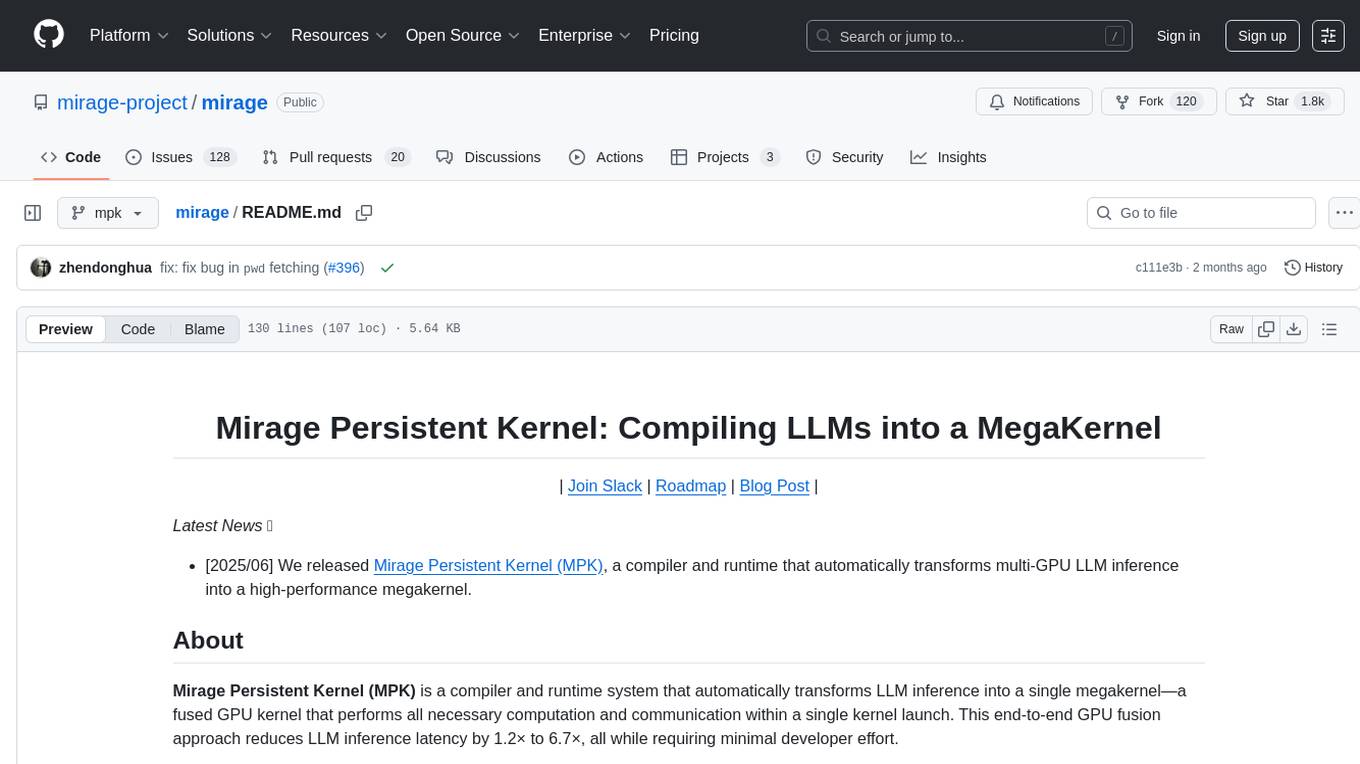
mirage
Mirage Persistent Kernel (MPK) is a compiler and runtime system that automatically transforms LLM inference into a single megakernel—a fused GPU kernel that performs all necessary computation and communication within a single kernel launch. This end-to-end GPU fusion approach reduces LLM inference latency by 1.2× to 6.7×, all while requiring minimal developer effort.
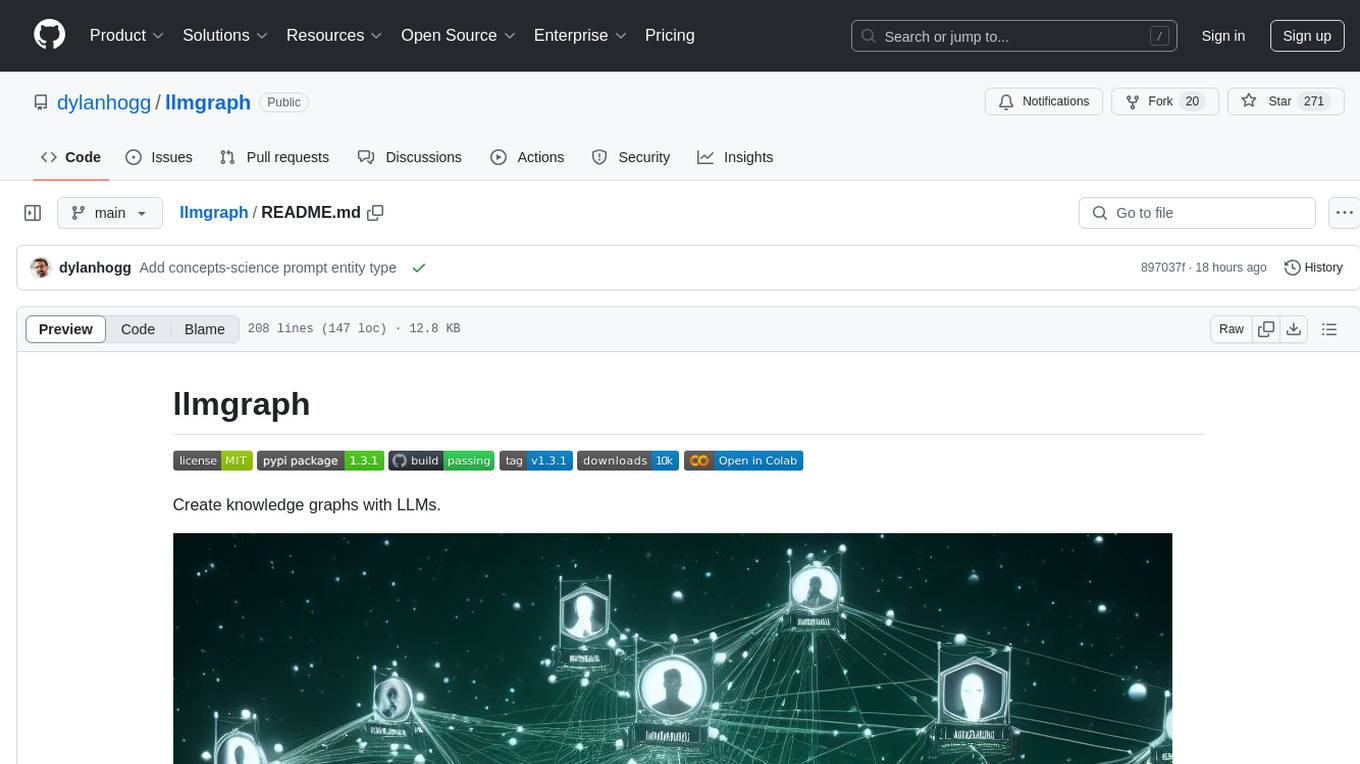
llmgraph
llmgraph is a tool that enables users to create knowledge graphs in GraphML, GEXF, and HTML formats by extracting world knowledge from large language models (LLMs) like ChatGPT. It supports various entity types and relationships, offers cache support for efficient graph growth, and provides insights into LLM costs. Users can customize the model used and interact with different LLM providers. The tool allows users to generate interactive graphs based on a specified entity type and Wikipedia link, making it a valuable resource for knowledge graph creation and exploration.
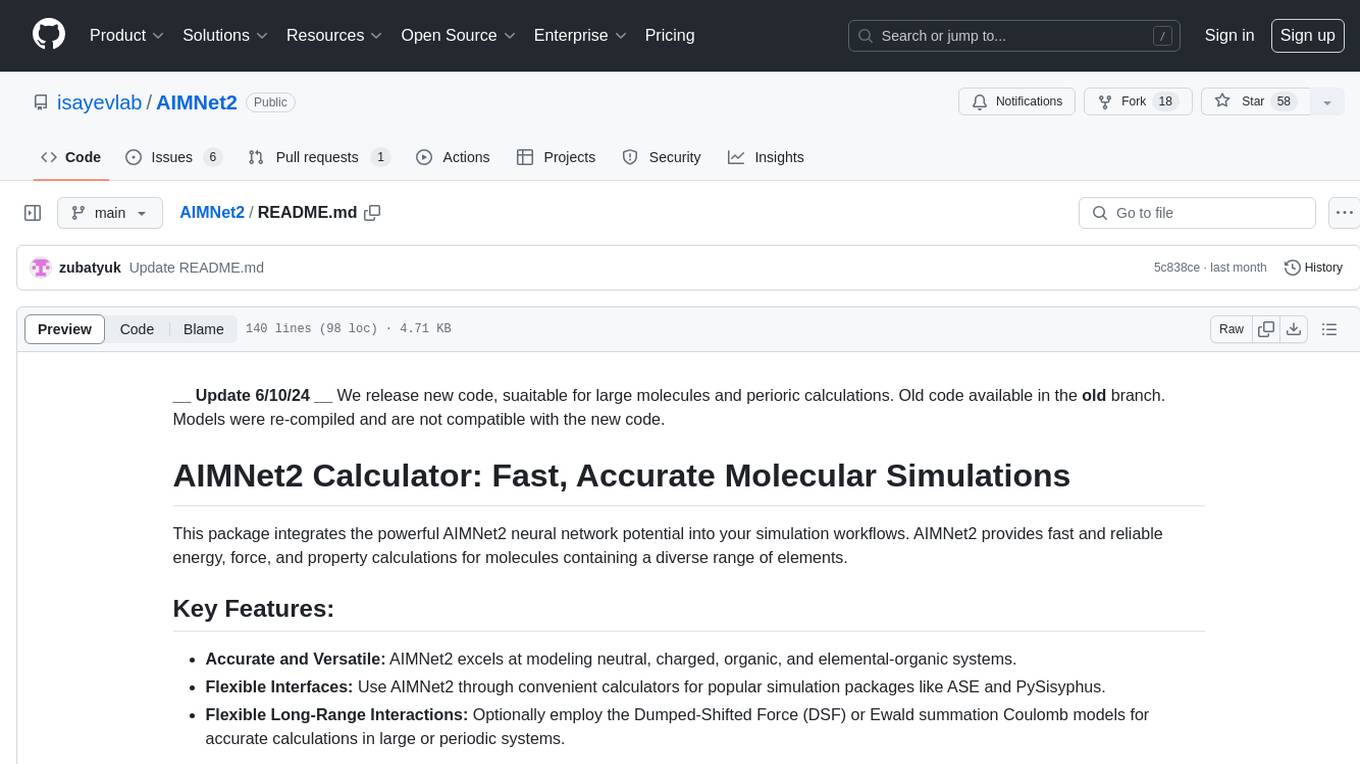
AIMNet2
AIMNet2 Calculator is a package that integrates the AIMNet2 neural network potential into simulation workflows, providing fast and reliable energy, force, and property calculations for molecules with diverse elements. It excels at modeling various systems, offers flexible interfaces for popular simulation packages, and supports long-range interactions using DSF or Ewald summation Coulomb models. The tool is designed for accurate and versatile molecular simulations, suitable for large molecules and periodic calculations.
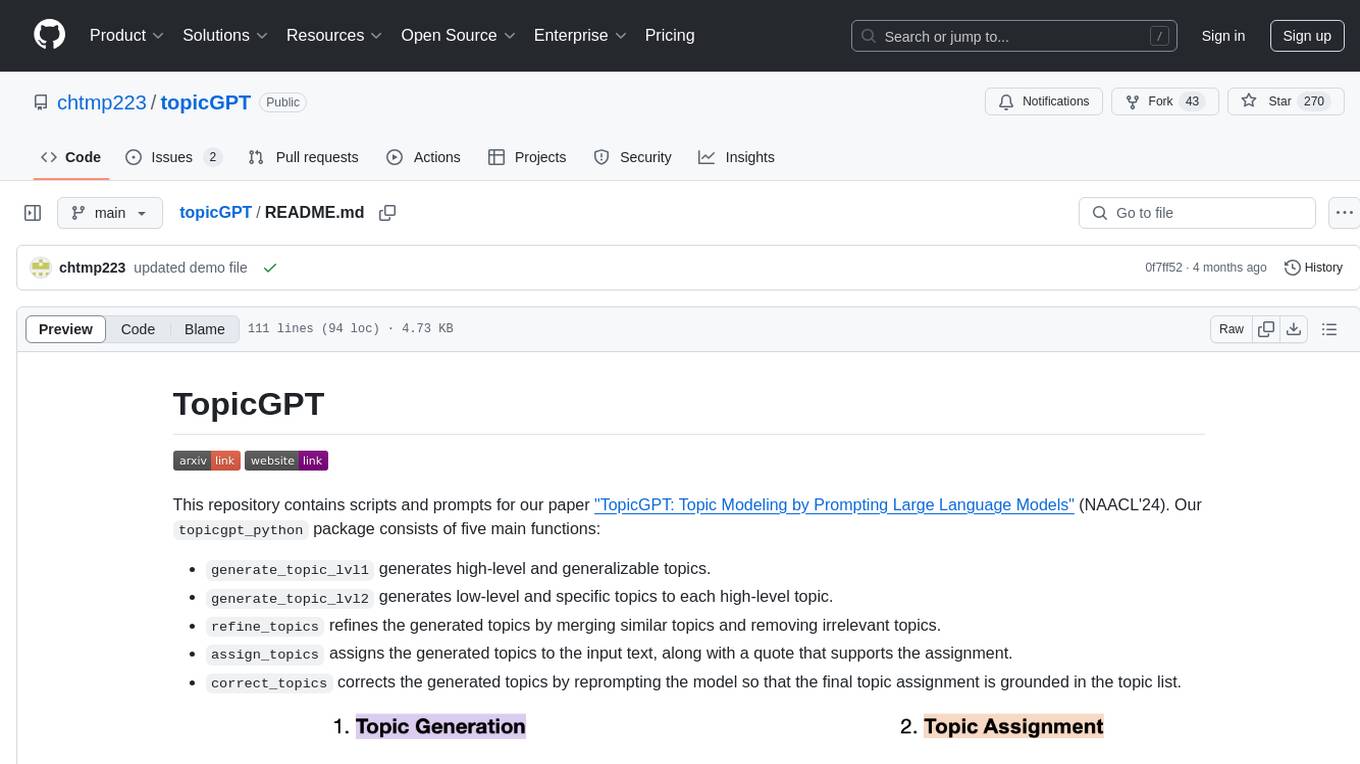
topicGPT
TopicGPT is a repository containing scripts and prompts for the paper 'TopicGPT: Topic Modeling by Prompting Large Language Models' (NAACL'24). The 'topicgpt_python' package offers functions to generate high-level and specific topics, refine topics, assign topics to input text, and correct generated topics. It supports various APIs like OpenAI, VertexAI, Azure, Gemini, and vLLM for inference. Users can prepare data in JSONL format, run the pipeline using provided scripts, and evaluate topic alignment with ground-truth labels.
For similar tasks
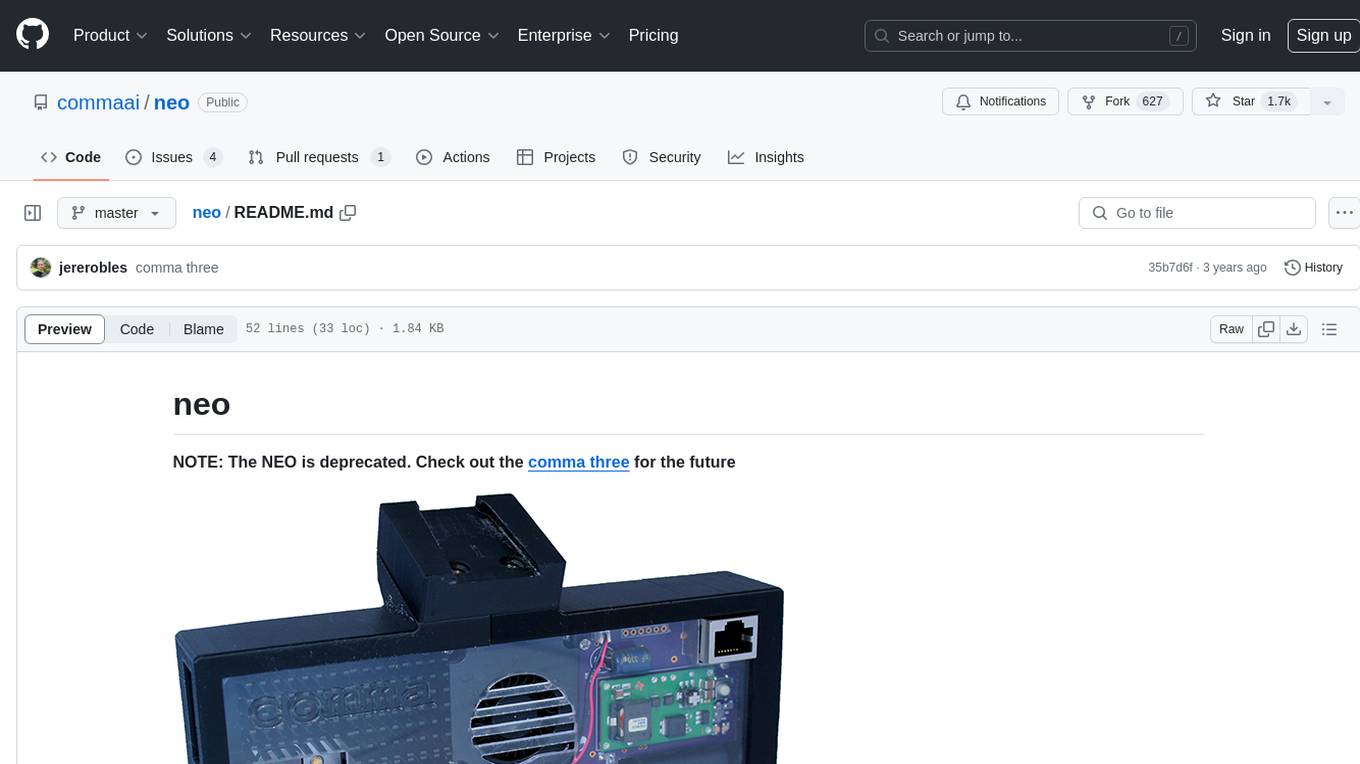
neo
The neo is an open source robotics research platform powered by a OnePlus 3 smartphone and an STM32F205-based CAN interface board, housed in a 3d-printed casing with active cooling. It includes NEOS, a stripped down Android ROM, and offers a modern Linux environment for development. The platform leverages the high performance embedded processor and sensor capabilities of modern smartphones at a low cost. A detailed guide is available for easy construction, requiring online shopping and soldering skills. The total cost for building a neo is approximately $700.

aigverse
aigverse is a Python infrastructure framework that bridges the gap between logic synthesis and AI/ML applications. It allows efficient representation and manipulation of logic circuits, making it easier to integrate logic synthesis and optimization tasks into machine learning pipelines. Built upon EPFL Logic Synthesis Libraries, particularly mockturtle, aigverse provides a high-level Python interface to state-of-the-art algorithms for And-Inverter Graph (AIG) manipulation and logic synthesis, widely used in formal verification, hardware design, and optimization tasks.
For similar jobs

aigverse
aigverse is a Python infrastructure framework that bridges the gap between logic synthesis and AI/ML applications. It allows efficient representation and manipulation of logic circuits, making it easier to integrate logic synthesis and optimization tasks into machine learning pipelines. Built upon EPFL Logic Synthesis Libraries, particularly mockturtle, aigverse provides a high-level Python interface to state-of-the-art algorithms for And-Inverter Graph (AIG) manipulation and logic synthesis, widely used in formal verification, hardware design, and optimization tasks.

weave
Weave is a toolkit for developing Generative AI applications, built by Weights & Biases. With Weave, you can log and debug language model inputs, outputs, and traces; build rigorous, apples-to-apples evaluations for language model use cases; and organize all the information generated across the LLM workflow, from experimentation to evaluations to production. Weave aims to bring rigor, best-practices, and composability to the inherently experimental process of developing Generative AI software, without introducing cognitive overhead.
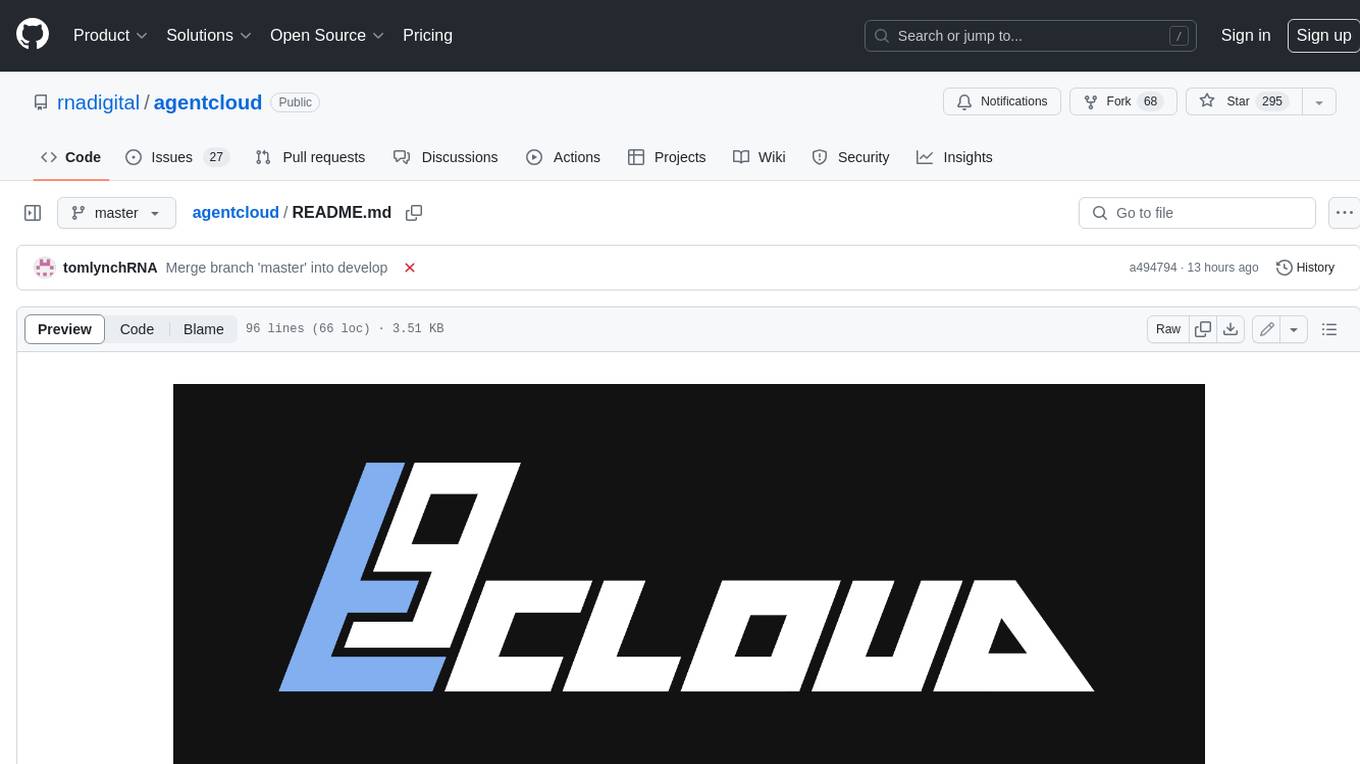
agentcloud
AgentCloud is an open-source platform that enables companies to build and deploy private LLM chat apps, empowering teams to securely interact with their data. It comprises three main components: Agent Backend, Webapp, and Vector Proxy. To run this project locally, clone the repository, install Docker, and start the services. The project is licensed under the GNU Affero General Public License, version 3 only. Contributions and feedback are welcome from the community.
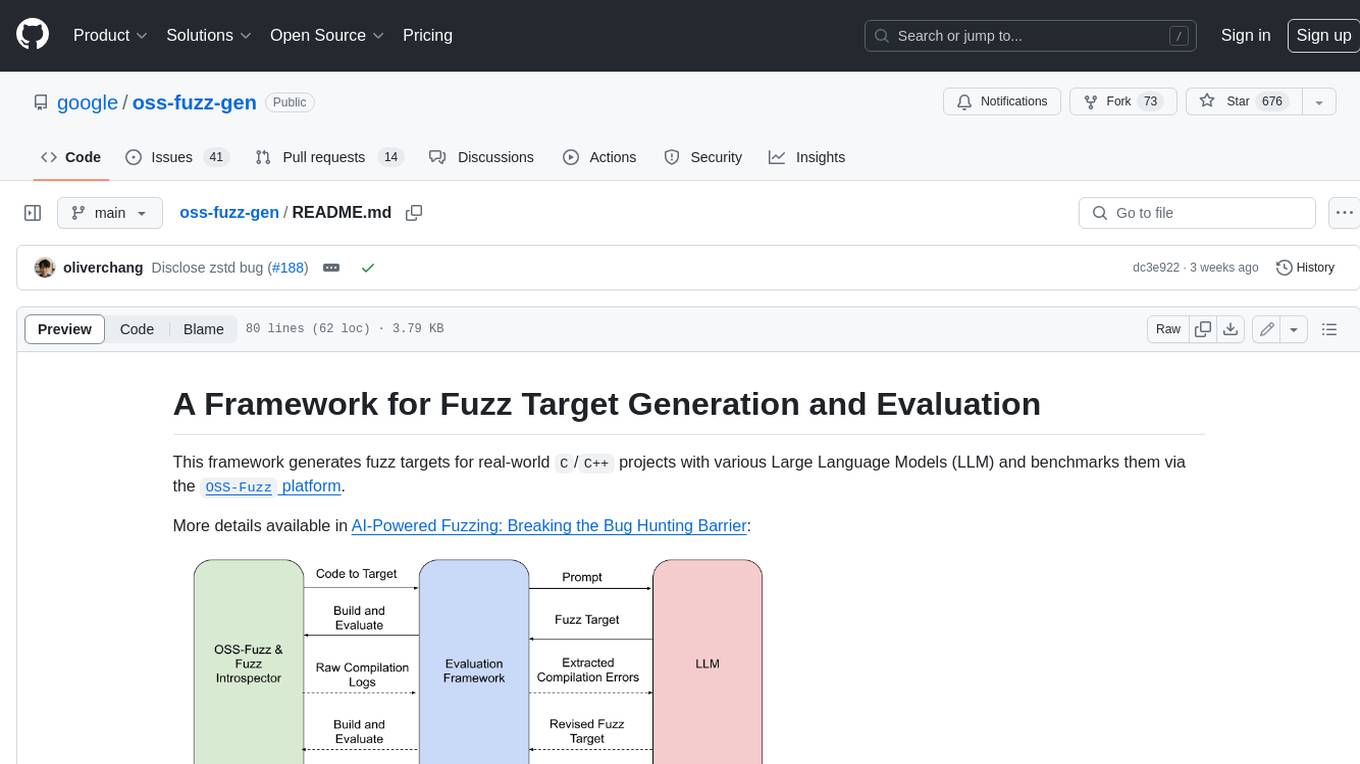
oss-fuzz-gen
This framework generates fuzz targets for real-world `C`/`C++` projects with various Large Language Models (LLM) and benchmarks them via the `OSS-Fuzz` platform. It manages to successfully leverage LLMs to generate valid fuzz targets (which generate non-zero coverage increase) for 160 C/C++ projects. The maximum line coverage increase is 29% from the existing human-written targets.

LLMStack
LLMStack is a no-code platform for building generative AI agents, workflows, and chatbots. It allows users to connect their own data, internal tools, and GPT-powered models without any coding experience. LLMStack can be deployed to the cloud or on-premise and can be accessed via HTTP API or triggered from Slack or Discord.

VisionCraft
The VisionCraft API is a free API for using over 100 different AI models. From images to sound.

kaito
Kaito is an operator that automates the AI/ML inference model deployment in a Kubernetes cluster. It manages large model files using container images, avoids tuning deployment parameters to fit GPU hardware by providing preset configurations, auto-provisions GPU nodes based on model requirements, and hosts large model images in the public Microsoft Container Registry (MCR) if the license allows. Using Kaito, the workflow of onboarding large AI inference models in Kubernetes is largely simplified.

PyRIT
PyRIT is an open access automation framework designed to empower security professionals and ML engineers to red team foundation models and their applications. It automates AI Red Teaming tasks to allow operators to focus on more complicated and time-consuming tasks and can also identify security harms such as misuse (e.g., malware generation, jailbreaking), and privacy harms (e.g., identity theft). The goal is to allow researchers to have a baseline of how well their model and entire inference pipeline is doing against different harm categories and to be able to compare that baseline to future iterations of their model. This allows them to have empirical data on how well their model is doing today, and detect any degradation of performance based on future improvements.





